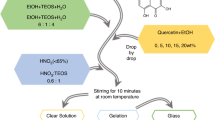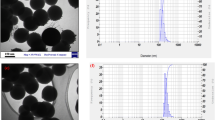Abstract
The development of advanced functional materials, capable of providing effective antimicrobial activity, has a big demand from the contemporary society. Advanced functional antimicrobial amorphous silica composites (ASC) are prepared by using sol–gel process and modified by Zn ions and rare-earth element Lu. The preparation conditions are optimized by single-factor analysis, and as-prepared functional hybrids are characterized by scanning electron microscopy (SEM), X-ray diffraction analysis, X-ray photoelectron spectroscopy (XPS), atomic adsorption spectrometry and inductively coupled plasma analyses. The presence of homogeneously mixed Zn and Lu, in the form of ZnO and Lu2O3, and dense micropores is confirmed by SEM and XPS. The amorphous structure and large surface area are beneficial for better antimicrobial performance. The as-prepared Zn–Lu ASC exhibited excellent antimicrobial properties against Escherichia coli and Staphylococcus aureus. We demonstrate that the addition of rare-earth element, Lu, has rendered synergistic effect on antimicrobial properties by increasing the release of Zn ions and generating excess reactive oxygen species. The present study provides a mechanistic insight and novel approach to fabricate functional antimicrobial materials for a wide range of applications.








Similar content being viewed by others
References
Choi J, Yang BJ, Bae GN, Jung JH (2015) Herbal extract incorporated nanofiber fabricated by an electrospinning technique and its application to antimicrobial air filtration. ACS Appl Mater Interfaces 7:25313–25320
Ni S, Li X, Yang P, Ni S, Hong F, Webster TJ (2016) Enhanced apatite-forming ability and antibacterial activity of porous anodic alumina embedded with CaO–SiO2–Ag2O bioactive materials. Mater Sci Eng C 58:700–708
Diez-Pascual AM, Diez-Vicente AL (2015) Nano-TiO2 reinforced PEEK/PEI blends as biomaterials for load-bearing implant applications. ACS Appl Mater Interfaces 7:5561–5573
Tang B, Wang J, Xu S, Afrin T, Xu W, Sun L, Wang X (2011) Application of anisotropic silver nanoparticles: multifunctionalization of wool fabric. J Colloid Interface Sci 356:513–518
Taheri S, Cavallaro A, Christo SN, Smith LE, Majewski P, Barton M, Hayball JD, Vasilev K (2014) Substrate independent silver nanoparticle based antibacterial coatings. Biomaterials 35:4601–4609
Du C, Shi J, Shi J, Zhang L, Cao S (2013) PUA/PSS multilayer coated CaCO3 microparticles as smart drug delivery vehicles. Mater Sci Eng C 33:3745–3752
Wang W, Xiao K, He T, Zhu L (2015) Synthesis and characterization of Ag nanoparticles decorated mesoporous sintered activated carbon with antibacterial and adsorptive properties. J Alloys Compd 647:1007–1012
Miola M, Perero S, Ferraris S, Battiato A, Manfredotti C, Vittone E, Del Vento D, Vada S, Fucale G, Ferraris M (2014) Silver nanocluster-silica composite antibacterial coatings for materials to be used in mobile telephones. Appl Surf Sci 313:107–115
Li Z, Zhang F, Meng A, Xie C, Xing J (2015) ZnO/Ag micro/nanospheres with enhanced photocatalytic and antibacterial properties synthesized by a novel continuous synthesis method. RSC Adv 5:612–620
Sasaki K, Matsubara K, Kawamura S, Saito K, Yagi M, Norimatsu W, Sasai R, Yui T (2016) Synthesis of copper nanoparticles within the interlayer space of titania nanosheet transparent films. J Mater Chem C 4:1476–1481
Karthik R, Thambidurai S (2017) Synthesis of cobalt doped ZnO/reduced graphene oxide nanorods as active material for heavy metal ions sensor and antibacterial activity. J Alloys Compd 715:254–265
Shirkavand Hadavand B, Ataeefard M, Fakharizadeh Bafghi H (2015) Preparation of modified nano ZnO/polyester/TGIC powder coating nanocomposite and evaluation of its antibacterial activity. Compos B Eng 82:190–195
Wong T-T, Lau K-T, Tam W-Y, Etches JA, Kim J-K, Wu Y (2016) Effects of silane surfactant on Nano-ZnO and rheology properties of nano-ZnO/epoxy on the UV absorbability of nano-ZnO/epoxy/micron-HGF composite. Compos B Eng 90:378–385
Ravichandran K, Chidhambaram N, Gobalakrishnan S (2016) Copper and graphene activated ZnO nanopowders for enhanced photocatalytic and antibacterial activities. J Phys Chem Solids 93:82–90
Yu Q, Xu X, Wang C, Ma Y, Hui D, Zhou Z (2017) Remarkably improvement in antibacterial activity by synergistic effect in n-Cu@T-ZnO nanocomposites. Compos B Eng 110:32–38
Sedlak J, Bazant P, Klofac J, Pastorek M, Kuritka I (2015) Antibacterial composite based on nanostructured ZnO mesoscale particles and a poly (vinyl chloride) matrix. Mater Technol 49:55–59
Wu J, Zhang G, Liu J, Gao H, Song C, Du H, Zhang L, Gong Z, Lü Y (2014) Synthesis, characteristics, and antibacterial activity of a rare-earth samarium/silver/titanium dioxide inorganic nanomaterials. J Rare Earth 32:727–732
Turkoz MB, Nezir S, Varilci A, Yildirim G, Akdogan M, Terzioglu C (2012) Experimental and theoretical approaches on magnetoresistivity of Lu-Doped Y-123 superconducting ceramics. J Mater Sci Mater Electron 24:1536–1545
Gao X, Liu H, Yang X, Tian Y, Lu X, Han L (2017) A novel Eu3+/Eu2+ co-doped MgSrLa8(SiO4)6O2 single-phase white light phosphor for white LEDs. RSC Adv 7:1711–1717
Jayachandraiah C, Krishnaiah G, Kumar KS (2014) Ce induced structural and optical properties of Ce doped ZnO nanoparticles. Int J ChemTech Res 6:3378–3381
Duan X, Ren F, Chang L (2016) Preparation and characterization of Cu-rare earth/Al2O3 catalysts and their application in the electrochemical removal of p-nitrophenol. RSC Adv 6:106387–106395
Wang K, Wu Y, Li H, Li M, Guan F, Fan H (2014) A hybrid antioxidizing and antibacterial material based on Ag–La2O3 nanocomposites. J Inorg Biochem 141:36–42
Ramya S, Ruth Nithila SD, George RP, Krishna DNG, Thinaharan C, Kamachi Mudali U (2013) Antibacterial studies on Eu–Ag codoped TiO2 surfaces. Ceram Int 39:1695–1705
Sharma SK, Sudheer Pamidimarri DV, Kim DY, Na JG (2015) Y-doped zinc oxide (YZO) nanoflowers, microstructural analysis and test their antibacterial activity. Mater Sci Eng C 53:104–110
Li X, Gao G, Sun C, Zhu Y, Qu L, Jiang F, Ding H (2015) Preparation and antibacterial performance testing of Ag nanoparticles embedded biological materials. Appl Surf Sci 330:237–244
Moulder JF, Chastain J, King RCJ (1979) Handbook of X-ray photoelectron spectroscopy: a reference book of standard spectra for identification and interpretation of XPS data. Chem Phys Lett 220:7–10
Apalangya V, Rangari V, Tiimob B, Jeelani S, Samuel T (2014) Development of antimicrobial water filtration hybrid material from bio source calcium carbonate and silver nanoparticles. Appl Surf Sci 295:108–114
Zhu X, Wu D, Wang W, Tan F, Wong PK, Wang X, Qiu X, Qiao X (2016) Highly effective antibacterial activity and synergistic effect of Ag–MgO nanocomposite against Escherichia coli. J Alloys Compd 684:282–290
Gao G, Zhang B, Tang X, Jiang P, Wang X (2013) Study on copper–lutetium inorganic antibacterial materials. New Chem Mater 41:61–63
Acknowledgements
The work was supported by the National Natural Science Foundation of China under Grant No. 21677010; Joint Funds of the National Natural Science Foundation of China under Grant No. U1660109.
Author information
Authors and Affiliations
Corresponding author
Rights and permissions
About this article
Cite this article
Jiang, M., Zhang, B., Tang, X. et al. Preparation and characterization of hybrid antimicrobial materials based on Zn–Lu composites. J Mater Sci 53, 14922–14932 (2018). https://doi.org/10.1007/s10853-018-2688-3
Received:
Accepted:
Published:
Issue Date:
DOI: https://doi.org/10.1007/s10853-018-2688-3




